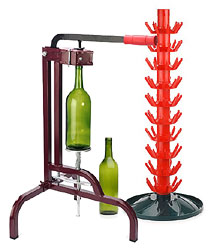 There are many steps to home winemaking, and each individual step is critical in maintaining the quality and acceptability of your homemade wine. First, you have to prepare the must either from juice or the fruit itself. Next, the must undergoes fermentation to convert the sugar in the must to alcohol. Further racking, clarifying, stabilizing, and aging steps help develop the wine to an even greater quality. Once you’ve past these steps, you may think you’re in the clear; however, bottling homemade wine is just as important as any one of the previous steps for maintaining homemade wine quality.
There are many steps to home winemaking, and each individual step is critical in maintaining the quality and acceptability of your homemade wine. First, you have to prepare the must either from juice or the fruit itself. Next, the must undergoes fermentation to convert the sugar in the must to alcohol. Further racking, clarifying, stabilizing, and aging steps help develop the wine to an even greater quality. Once you’ve past these steps, you may think you’re in the clear; however, bottling homemade wine is just as important as any one of the previous steps for maintaining homemade wine quality.
The first thing you need to do prior to bottling homemade wine is to prepare the wine bottles. You need to be sure the wine bottles you use are clean, not cracked or chipped, and free from all labels. If you recycle old bottles, remove the labels thoroughly by soaking in hot water and cleaner designed to clean winemaking equipment. For drying many bottles at once, it would be wise to invest in a bottle tree: they are great for drying and storing bottles while you wait to use them for bottling homemade wine.
The next step in bottling homemade wine is to prepare the wine bottle corks. You’ll need to decide if you would like to use natural cork or synthetic cork, though the use of synthetic cork is becoming more and more popular for bottling homemade wine in recent years.
To get the wine into your bottles, you may either pour directly from the spout on your storage container, or if you have a lot of wine to bottle or you’d like to get the process of bottling homemade wine done faster, a bottle filler is a great investment. This device allows you to fill multiple bottles at once, thus increasing your output and significantly reducing your bottling time.
The final step in bottling homemade wine is sealing them with corks. There are a lot great pieces of equipment out there that will help you in the process, as no one is strong enough to push a cork into a bottle of wine with just their bare hands. There are several different styles of corkers, from smaller hand-held devices or mid-sized bench top devices for small to medium quantities of wine, to larger floor corkers that are better for larger quantities of wine.
Whichever method you choose, bottling homemade wine is a step that is critical in ensuring and sealing in the quality of the wine while in storage.
———————————————————————————————————
Ed Kraus is a 3rd generation home brewer/winemaker and has been an owner of E. C. Kraus since 1999. He has been helping individuals make better wine and beer for over 25 years.

Do the corks need to be sanatized with metabisulfate prior to using? I’m talking about new corks that are coming straight from a sealed bag.
Jerry, we recommend sanitizing the corks in a sulfite solution before using them. There are two exceptions to this: 1)if you are doing a quick steaming of the corks to make them more pliable for your corker, 2) You are using the corks straight out of the original cork mfgs. bag. This is usually a bag of 1,000 or sometimes 500. In these cases the corks are packaged under sulfur dioxide and ready to go.
Will the hand inserted mushroom corks fit the bottle so snugly that the bottle can be stored in inclined position? Can these corks be reused after sanitization?
Shishir, we do not recommend store these bottle on their side. They do not seal as tightly as when a cork is pressed into a bottle with a corker. Regular Mushroom corks can not be sanitized and reused, however the synthetic Mushroom corks can.
What can we do with the used agglomerated cork’s ??? can they be reused if sanitized again ??
Dean, wine corks should never be reused, regardless if they are agglomerated, sold or dust-filled. The primary reason is because wine has soaked deep into the cork over several months. There is no way to sanitize the cork for this reason.